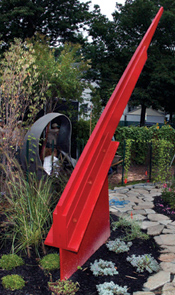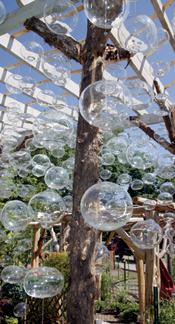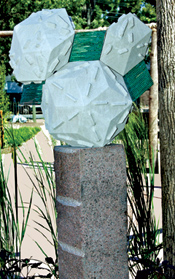Gallery: Quark Park
Science in the park
 |
 The Weather Garden Birch trees, stained glass, bamboo, sun, wind, rain Artists: Holly Grace Nelson and Matt Kiefer Scientist: George Philander, Geosciences Weather, always difficult to predict, is a chaotic system. To create order and understanding, scientists pose selective questions and answer them in idealized contexts. The Weather Garden represents this approach, featuring an orderly sun garden (photo), a path under raining arches, and a cloud garden with a fog system. An oculus filled with stained glass symbolizes the sun. "A true gardener acknowledges nature's constraints and within them creates an island of order in a sea of disorder," says Philander. |
| Stellarator Aluminum tubing, styrofoam Artist: Rein Triefeldt Scientist: Rob Goldston, Plasma Physics This 16-foot structure represents an experimental fusion device called a stellarator, or star generator. The bright pink styrofoam sculpture has the cruller-doughnut shape of the plasma to be produced by the National Compact Stellarator Experiment (NCSX), scheduled to begin operation in 2009. Pink depicts the color of the plasma–the hot, ionized gas used as fusion fuel–although fusion plasmas would be most visible to those able to see X-rays. |
 |
| Sensation: Interior View Multi-colored cast resin discs, steel, wires Artist: Nancy Cohen with help from James Sturm, Electrical Engineering Scientist: Shirley Tilghman, Molecular Biology Discussions with Tilghman about research in molecular biology, in particular the Nobel Prize-winning research by Richard Axel and Linda Buck, inspired this installation. The sculpture symbolizes how odors are recognized and remembered. The multi-colored discs represent the neurons in the nose that detect different odorant molecules, and the wires correspond to the axonal connections that pass through the skull to the olfactory bulb in the brain. The wires light up, and each color indicates the response to a different odor. |
Photos by Elle Starkman,
Princeton Plasma Physics Laboratory
Text by Patti Wieser,
Princeton Plasma Physics Laboratory
 |
| Augmented Lithophone Granite, steel, microphones, loudspeakers Artist: Jonathan Shor Scientist: Perry Cook, Computer Science and Psychoacoustics This lithophone sculpture is made of 17 resonant granite columns that ring when struck, resembling a stone xylophone. A piezoelectric contact microphone at each "bar" transfers the vibrations to a box containing digital signal processing equipment, which adds delays and reverb to the sounds and simulates a cave-like environment. Viewers are invited to "play" the lithophone by striking the granite posts. Cook composed a musical rendition of Shor splitting stone; a recording of the piece is played constantly around the sculpture. |
There's a new scientific path in Princeton, New Jersey. Out of the loam of a vacant lot, a cluster of quasicrystals winks at some pink plasma. Tectonic plates shift, and neurons connect in a hippocampus curve of bamboo. In one corner, colorful cells that detect and transmit smells to the brain sparkle in the sunlight.
Quark Park is a new–though temporary–15,000-square-foot sculpture garden. Its art and plantings reflect research in fusion energy, mountain range formation, robotics, neuroscience, and other areas of science.
Alan Goodheart, Peter Soderman, and Kevin Wilkes, who conceived, designed, and organized Quark Park, sum up the garden as a celebration of "the mysteries of science and art, and the contributions of Princeton area scientists and designers." In 2004, the trio developed the award-winning Writers Block at the same location, a concept that brought together writers and designers.
"We want the visitors of the park to have a moment of enjoyment, a glimpse of beauty, and a sense of the dimensions of contemporary science," says Wilkes, a Princeton architect. "We want all members of the public, children of all ages, people of all ethnicities, to be able to find a moment of delight and hope in this park. We want children to connect to the realm of science in a way that is fascinating and intriguing without having to resort to a blackboard and a textbook."
More than a dozen well-known scientists participated in the project, including Shirley Tilghman, molecular biologist and president of Princeton University; Rush Holt, physicist and US Representative from New Jersey's 12th Congressional District; Freeman Dyson, scientist and author; Paul Steinhardt, theoretical physicist; and Rob Goldston, director of the Princeton Plasma Physics Laboratory. They served as the artists' muses, and the collaborations have yielded a stunning collision of art, architecture, and landscaping that reflect scientific concepts.
 |
Hippocampus Bamboo, concrete, fiberglass, steel Artists: Steve Weiss and Dolph Geurds Scientist: Tracey Shors, Neuroscience Shors' research focuses on understanding how memories are formed and stored in the brain. She says that brains, especially neuron projections called dendrites and nerve fibers known as axons, resemble tree branches. Hippocampus symbolizes the area of the brain that plays a part in learning. Geurds and his staff placed tall bamboo in concrete, creating a hippocampus-like shape. Weiss created two 30-inch-tall masks of cement reinforced with fiberglass and steel that represent a man and a woman. Boxwood tree roots shooting out of the mask tops mimic branching dendrites in the brain. |
The garden paths form a labyrinth, shaded by canopies of aluminum, wood, and plants. At the center is the Inner Circle, an urban piazza that serves as the locus of parties, receptions, dances, and tours of the garden, as well as a place for people to pause and chat.
Quark Park's grand opening was September 8. Open to the public and for community events, the garden will operate through Thanksgiving. Once it closes, each installation belongs to the artist, who may keep, sell, or donate his or her piece.
More information about Quark Park and the scientist-artist teams is at www.princetonoccasion.org/quarkpark/
 |
 |
 |
| Sundial Steel, wood Artist: Allan Kehrt Scientists: Freeman Dyson and Rush Holt, Physics Architect Kehrt teamed up with Dyson, professor emeritus at the Institute for Advanced Study, and US Representative Holt, former assistant director of the DOE Princeton Plasma Physics Laboratory. His installation, a vibrant wood shadow maker set on an 800-pound steel base, is about the sun, fusion, and nuclear energy. The chili-pepper-red gnomon soars above nearby cornstalks and casts a shadow on a flat panel marked with the day's hours. |
Motion in the Ocean Material: Glass, wood Artist: Robert Kuster Scientist: Naomi Ehrich Leonard, Mechanical and Aerospace Engineering Leonard's research focuses on feedback–the responsive behavior of groups. She uses mathematical concepts of synchrony and interconnection to model and analyze natural collectives, and to design robotic collectives. Motion in the Ocean contains 2000 clear blown-glass bubbles ranging from 5 to 10 inches in diameter, a school of 25 glass fish, and a fleet of four glass robotic underwater gliders. The bubbles create the underwater world. The schooling fish and gliders are reminiscent of a well-choreographed dance of animals–or robots–that move as a group. Individual animals respond to the motion of others nearby, representing the concept of feedback. |
Forbidden Geometry Indiana limestone, granite, glass Artist: Christoph Spath Scientist: Paul J. Steinhardt, Physics Quasicrystals are a new class of materials whose atomic arrangements exhibit symmetries that do not fit the definition of crystals. Correspondingly, quasicrystals have physical properties different from crystals. One "forbidden" geometry observed in quasicrystals is the five-fold symmetry, depicted in this installation. Says Steinhardt, "The sculpture shows a cluster with four types of interlocking units that could be continued to fill Quark Park and beyond in a pattern with icosahedral symmetry." |
Click here to download the pdf version of this article.






